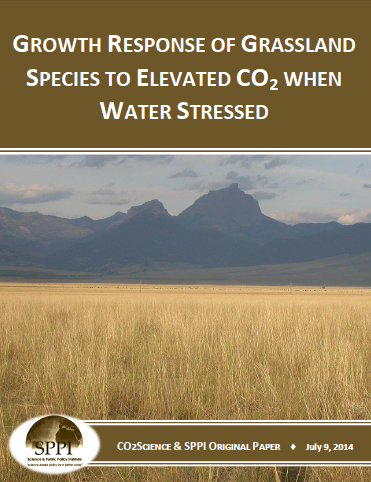News / Science & Technology
GROWTH RESPONSE OF GRASSLAND SPECIES TO ELEVATED CO2 WHEN WATER STRESSED

As the air's CO2 content continues to rise, nearly all of earth's plants should exhibit increases in photosynthesis and biomass production; but climate alarmists periodically claim that water stress will negate these benefits. In reviewing the scientific literature of the ten-year period 1983-1994, however, Idso and Idso (1994) concluded that water stress will not negate the CO2 induced stimulation of plant productivity. In fact, they discovered that the CO2 induced percentage increase in plant productivity was nearly always greater under water-stressed conditions than it was when plants were wellwatered. And seven years later, Poorter and Perez-Soba (2001) conducted a similar literature review and came to the same conclusion. In this summary, therefore, we provide some background for this phenomenon and highlight some of the most impressive work that has subsequently been done in this area.
Elevated levels of atmospheric CO2 tend to reduce the area of open stomatal pore space on leaf surfaces, thus reducing plant stomatal conductance. This phenomenon, in turn, effectively reduces the amount of water lost to the atmosphere via transpiration. In the study of Leymarie et al. (1999) , for example, twice-ambient levels of atmospheric CO2 caused significant reductions in the stomatal conductance of water-stressed Arabidopsis thaliana. Similarly, Volk et al. (2000) reported finding that several calcareous grassland species exposed to elevated CO2 concentrations (600 ppm) consistently exhibited reduced stomatal conductance, regardless of soil moisture availability. Thus, atmospheric CO2 enrichment nearly always reduces stomatal conductance and, hence, plant
At the same time, CO2-induced increases in root development and CO2-induced reductions in leaf stomatal conductance often combine to maintain a more favorable plant water status during times of drought. In the case of four grassland species comprising a pasture characteristic of New Zealand, for example, Clark et al. (1999) found that leaf water potential, which is a good indicator of plant water status, was consistently higher (less negative and, therefore, less stressful) under elevated atmospheric CO2 concentrations. Likewise, leaf water potentials of the water-stressed C4 grass Panicum coloratumgrown at 1000 ppm CO2 were always higher than those of their water-stressed counterparts growing in ambient air (Seneweera et al., 2001 ). In fact, Seneweera et al. (1998) had earlier reported that leaf water potentials observed in CO2-enriched water-stressed plants were an amazing three-and-a-half times greater than those observed in control plants grown at 350 ppm during drought conditions (Seneweera et al., 1998 ).
